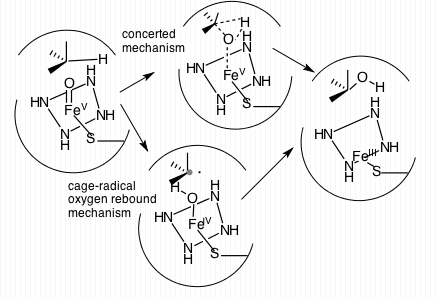|
Paritaprevir
Paritaprevir (previously known as ABT-450) is an acylsulfonamide inhibitor of the NS3- 4A serine protease manufactured by Abbott Laboratories that shows promising results as a treatment of hepatitis C. When given in combination with ritonavir and ribavirin for 12 weeks, the rate of sustained virologic response at 24 weeks after treatment has been estimated to be 95% for those with hepatitis C virus genotype 1. Resistance to treatment with paritaprevir is uncommon, because it targets the binding site In biochemistry and molecular biology, a binding site is a region on a macromolecule such as a protein that binds to another molecule with specificity. The binding partner of the macromolecule is often referred to as a ligand. Ligands may includ ..., but has been seen to arise due to mutations at positions 155 and 168 in NS3. Paritaprevir was a component of Viekira Pak and Technivie. In May 2018, the FDA announced that Technivie and Viekira were to be discontinued. The discon ... [...More Info...] [...Related Items...] OR: [Wikipedia] [Google] [Baidu] |
Viekira Pak
Ombitasvir/paritaprevir/ritonavir, sold under the brand name Technivie among others, is a medication used to treat hepatitis C. It is a fixed-dose combination of ombitasvir, paritaprevir, and ritonavir. Specifically it is used together with dasabuvir or ribavirin for cases caused by hepatitis C virus genotype 1 or 4. Cure rates are around 95%. It is taken by mouth. It is generally well tolerated. Common side effects include nausea, itchiness, rash, and trouble sleeping. Other side effects include allergic reactions and reactivation of hepatitis B among those previously infected. Use is not recommended in those with significant liver problems. While there is no evidence of harm with use during pregnancy, this use has not been well studied. Each of the medications works by a different mechanism. The ritonavir is present to decrease the breakdown of paritaprevir. Ombitasvir/paritaprevir/ritonavir with dasabuvir was approved for medical use in the United States in December ... [...More Info...] [...Related Items...] OR: [Wikipedia] [Google] [Baidu] |
Dasabuvir
Dasabuvir, sold under the brand name Exviera, is an antiviral medication for the treatment of hepatitis C. It is often used together with the combination medication ombitasvir/paritaprevir/ritonavir specifically for hepatitis C virus (HCV) type 1. Ribavirin may also additionally be used. These combinations result in a cure in more than 90% of people. It is taken by mouth. Common side effects include trouble sleeping, nausea, itchiness, and feeling tired. It is not recommended in those with liver failure but appears okay in people with kidney disease. While there is no evidence of harm if used during pregnancy, it has not been well studied. It should not be used with birth control pills that contain ethinylestradiol. Dasabuvir is in the HCV NS5B polymerase inhibitor class of medication. Dasabuvir was approved for medical use in 2014. It is on the World Health Organization's List of Essential Medicines. In the United States, it is approved by the Food and Drug Administration (F ... [...More Info...] [...Related Items...] OR: [Wikipedia] [Google] [Baidu] |
Ombitasvir
Ombitasvir is an antiviral drug for the treatment of hepatitis C virus (HCV) infection by AbbVie. In the United States, it is approved by the Food and Drug Administration for use in combination with paritaprevir, ritonavir and dasabuvir in the product Viekira Pak for the treatment of HCV genotype 1, and with paritaprevir and ritonavir Ritonavir, sold under the brand name Norvir, is an antiretroviral medication used along with other medications to treat HIV/AIDS. This combination treatment is known as highly active antiretroviral therapy (HAART). Ritonavir is a protease inhi ... in the product Technivie for the treatment of HCV genotype 4. Ombitasvir is an NS5A inhibitor that acts by inhibiting the HCV protein NS5A. See also * Discovery and development of NS5A inhibitors References Further reading * * Carbamates NS5A inhibitors Pyrrolidines {{Antiinfective-drug-stub ... [...More Info...] [...Related Items...] OR: [Wikipedia] [Google] [Baidu] |
Hepatitis C
Hepatitis C is an infectious disease caused by the hepatitis C virus (HCV) that primarily affects the liver; it is a type of viral hepatitis. During the initial infection period, people often have mild or no symptoms. Early symptoms can include fever, dark urine, abdominal pain, and jaundice, yellow tinged skin. The virus persists in the liver, becoming Chronic condition, chronic, in about 70% of those initially infected. Early on, chronic infection typically has no symptoms. Over many years however, it often leads to liver disease and occasionally cirrhosis. In some cases, those with cirrhosis will develop serious complications such as liver failure, hepatocellular carcinoma, liver cancer, or esophageal varices, dilated blood vessels in the esophagus and gastric varices, stomach. HCV is spread primarily by blood-to-blood contact associated with injection drug use, poorly sterilized medical equipment, needlestick injuries in healthcare, and blood transfusions, transfusions. In r ... [...More Info...] [...Related Items...] OR: [Wikipedia] [Google] [Baidu] |
Ritonavir
Ritonavir, sold under the brand name Norvir, is an antiretroviral medication used along with other medications to treat HIV/AIDS. This combination treatment is known as highly active antiretroviral therapy (HAART). Ritonavir is a protease inhibitor, though it now mainly serves to boost the potency of other protease inhibitor (pharmacology), protease inhibitors. It may also be used in combination with other medications to treat hepatitis C and COVID-19. It is taken Oral administration, by mouth. Common side effects of ritonavir include nausea, vomiting, loss of appetite, diarrhea, and numbness of the hands and feet. Serious side effects include liver complications, pancreatitis, allergic reactions, and arrhythmias. Serious interactions may occur with a number of other medications including amiodarone and simvastatin. At low doses, it is considered to be acceptable for use during pregnancy. Ritonavir is of the protease inhibitor class. However, it is also commonly used to inhibi ... [...More Info...] [...Related Items...] OR: [Wikipedia] [Google] [Baidu] |
NS3 (HCV)
Nonstructural protein 3 (NS3), also known as p-70, is a viral nonstructural protein that is 70 kDa cleavage product of the hepatitis C virus polyprotein. It acts as a serine protease. C-terminal two-thirds of the protein also acts as helicase and nucleoside triphosphatase. First (N-terminal) 180 aminoacids of NS3 has additional role as cofactor domains for NS2 protein. See also * Boceprevir, sovaprevir, paritaprevir and telaprevir Telaprevir (VX-950), marketed under the brand names Incivek and Incivo, is a pharmaceutical drug for the treatment of hepatitis C co-developed by Vertex Pharmaceuticals and Johnson & Johnson. It is a member of a class of antiviral drugs known as ... - drugs targeting this protein References External links * http://www.uniprot.org/uniprot/Q91RS4 Viral nonstructural proteins Hepatitis C virus {{virus-stub ... [...More Info...] [...Related Items...] OR: [Wikipedia] [Google] [Baidu] |
CYP3A5
Cytochrome P450 3A5 is a protein that in humans is encoded by the ''CYP3A5'' gene. Tissue distribution ''CYP3A5'' encodes a member of the cytochrome P450 superfamily of enzymes. Like most of the cytochrome P450, the CYP3A5 is expressed in the prostate and the liver. It is also expressed in epithelium of the small intestine and large intestine for uptake and in small amounts in the bile duct, nasal mucosa, kidney, adrenal cortex, epithelium of the gastric mucosa with intestinal metaplasia, gallbladder, intercalated ducts of the pancreas, chief cells of the parathyroid and the corpus luteum of the ovary (at protein level). Clinical significance The cytochrome P450 proteins are monooxygenases which catalyze many reactions involved in drug metabolism and synthesis of cholesterol, steroids and other lipids. This protein localizes to the endoplasmic reticulum and its expression is induced by glucocorticoids and some pharmacological agents. The enzyme metabolizes drugs such as nif ... [...More Info...] [...Related Items...] OR: [Wikipedia] [Google] [Baidu] |
CYP3A4
Cytochrome P450 3A4 (abbreviated CYP3A4) () is an important enzyme in the body, mainly found in the liver and in the intestine, which in humans is encoded by ''CYP3A4'' gene. It organic redox reaction, oxidizes small foreign organic molecules (xenobiotics), such as toxins or drugs, so that they can be removed from the body. It is highly homologous to CYP3A5, another important CYP3A enzyme. While many drugs are deactivated by CYP3A4, there are also some drugs that are ''activated'' by the enzyme. Some substances, such as some drugs and furanocoumarins present in grapefruit juice, interfere with the action of CYP3A4. These substances will, therefore, either amplify or weaken the action of those drugs that are modified by CYP3A4. CYP3A4 is a member of the cytochrome P450 family of oxidizing enzymes. Several other members of this family are also involved in drug metabolism, but CYP3A4 is the most common and the most versatile one. Like all members of this family, it is a hemoprote ... [...More Info...] [...Related Items...] OR: [Wikipedia] [Google] [Baidu] |
Cyclopropyl Compounds
A cyclopropyl group is a chemical structure derived from cyclopropane; it is typically produced in a cyclopropanation reaction. The group has an empirical formula of C3H5 and chemical bonds from each of the three carbons to both of the other two. Structure and bonding Due to the unfavoured bond angles (60°), cyclopropyl groups are highly strained. Two orbital models were proposed to describe the bonding situation. The Coulson-Moffit model uses bent bonds. The C-C bonds are formed by overlap of two sp-hybrid orbitals. To adapt to the small bond angle, there is some rehybridization resulting in sp~5-hybrids for the ring bonds and sp~2 for the C-H bonds. This model resembles the banana bond model for C=C double bonds (τ bonds). Alternatively the structure can be explained with the Walsh model. Here the two sp-hybrids forming the ring bond are separated into one sp2-hybrid and one pure p-orbital. This corresponds to the π bond description of C=C double bonds. Cyclopropyl grou ... [...More Info...] [...Related Items...] OR: [Wikipedia] [Google] [Baidu] |
Macrocycles
Macrocycles are often described as molecules and ions containing a Ring (chemistry), ring of twelve or more atoms. Classical examples include the crown ethers, calixarenes, porphyrins, and cyclodextrins. Macrocycles describe a large, mature area of chemistry. Synthesis The formation of macrocycles by ring-closure is called macrocyclization. The central challenge to macrocyclization is that ring-closing reactions do not favor the formation of large rings. Instead, medium sized rings or polymers tend to form. Early macrocyclizations were achieved ketonic decarboxylations for the preparation of terpenoid macrocycles. So, while Ružička was able to produce various macrocycles, the yields were low. This kinetic problem can be addressed by using high-dilution reactions, whereby intramolecular processes are favored relative to polymerizations. Reactions amenable to high dilution include Dieckmann condensation and related based-induced reactions of esters with remote halides. So ... [...More Info...] [...Related Items...] OR: [Wikipedia] [Google] [Baidu] |


